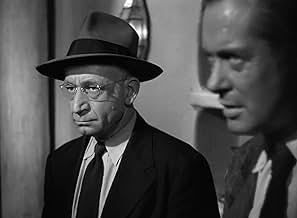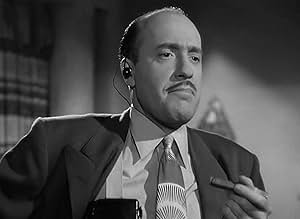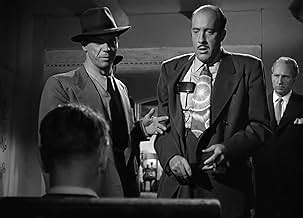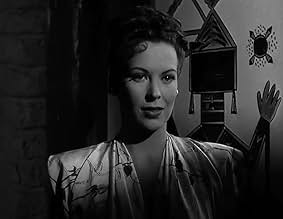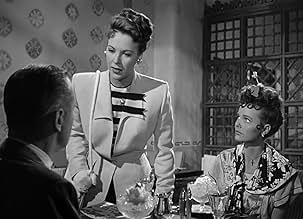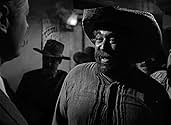IMDb RATING
7.2/10
3.5K
YOUR RATING
WW2 veteran Lucky Gagin arrives in a New Mexico border-town intent on revenging against mobster Frank Hugo but FBI agent Bill Retz, who also wants Hugo, tries to keep Gagin out of trouble.WW2 veteran Lucky Gagin arrives in a New Mexico border-town intent on revenging against mobster Frank Hugo but FBI agent Bill Retz, who also wants Hugo, tries to keep Gagin out of trouble.WW2 veteran Lucky Gagin arrives in a New Mexico border-town intent on revenging against mobster Frank Hugo but FBI agent Bill Retz, who also wants Hugo, tries to keep Gagin out of trouble.
- Nominated for 1 Oscar
- 1 nomination total
Storyline
Did you know
- TriviaFilmed in Santa Fe, the burning of Zozobra, which began in 1924, is still an annual festival occurring in September.
- GoofsOpening scene at the bus station, Montgomery walks over to the gum machine to insert his coin, but the gum package is already present before he inserts it.
- Crazy creditsThe main title card reads, "as LUCKY GAGIN in RIDE THE PINK HORSE." The film's title is in far smaller type than the character name.
- ConnectionsFeatured in Pulp Cinema (2001)
Featured review
An incredible film. There is so much going on and so much symbolism, the viewer cannot afford to miss a single moment. The great difficulty with attempting to make sense of most post WWII film noirs is that it is nearly impossible to relate to either the time in general or the turmoil the protagonist is going through after between one and three years in the somewhat surreal situation of extended combat. Attempting to `assimilate' to society can be extremely difficult. Many 'Nam vets can relate. At the time the film was made, just about everyone could relate because if they were not attempting to `assimilate' they knew someone who was.
The title comes from a scene where Lucky (Montgomery) wants to give Pilar (Hendrix) a free ride on Pancho's (Gomez) merry-go-round. Pilar asks Lucky which horse to ride and he replies, `Try the pink one'. What the merry-go-round is a metaphor of each viewer can decide. However, Pancho may give us a clue when during this exchange he states he gives no free rides.
Lucky is the typical movie G. I., brusque, rude and tougher than nails with apparently no real direction in life as evidenced by his cheap, rumpled suit and extremely free spending. Most assume he is out to revenge the killing of his war buddy, Shorty, by a gangster (Clark). Lucky is considered stupid because he could blackmail the gangster for much more than he is asking and essentially set himself up for life. However, Lucky recently left an environment where there was no guarantee of life beyond the moment. Is his motive actually revenge or could he be looking for something else? He recently survived a situation where his friends died on a regular basis and there was little or no opportunity for revenge. Can he even relate to revenge? You decide. At the end of the movie Lucky works out in his own mind a means of satisfying his motives. Enough said.
Pancho is the wise sage who periodically illuminates a situation with his light, off handed comments. The scheming, femme fatale (King) has a minor role, which is refreshing. However, the character who literally steals the show is Pilar a young, inexperienced, poor Indian girl who seems to mature into adulthood during the course of a few days. She attaches herself to Lucky at the beginning of the movie. The symbolism associated with her frequently appearing from behind buildings, out of alleys and hearing things no one else does is very strong and adds a true sense of mystery to the character. Retz ( blacklisted Art Smith), a government agent, and Pilar are often found protecting Lucky from himself. Pilar later explains to Retz that she befriended Lucky because she saw death in his face. Pilar assumes the `death' she saw is in the future but it could very well be that Lucky, after extended combat, is living a type of death at that moment. One of the movie's most compelling scenes is at the end when Lucky, knowing full well what he owes Pilar, has great difficulty determining how to say good-bye. Retz knows Lucky is struggling. Pilar, having greatly matured, understands either Lucky's predicament or `the facts of life' and handles the situation with the maturity of one well beyond her years. The beatings Pancho and Pilar take rather than betray Lucky also have strong symbolism, the weak defying the strong and eventually prevailing. Keep in mind this is 1947.
This is an extremely powerful movie that leaves so many questions unanswered, one cannot help but wonder long after the movie is over about what lead up to this small piece of Lucky's life, what was actually occurring during the movie and Lucky and Pilar's future.
The title comes from a scene where Lucky (Montgomery) wants to give Pilar (Hendrix) a free ride on Pancho's (Gomez) merry-go-round. Pilar asks Lucky which horse to ride and he replies, `Try the pink one'. What the merry-go-round is a metaphor of each viewer can decide. However, Pancho may give us a clue when during this exchange he states he gives no free rides.
Lucky is the typical movie G. I., brusque, rude and tougher than nails with apparently no real direction in life as evidenced by his cheap, rumpled suit and extremely free spending. Most assume he is out to revenge the killing of his war buddy, Shorty, by a gangster (Clark). Lucky is considered stupid because he could blackmail the gangster for much more than he is asking and essentially set himself up for life. However, Lucky recently left an environment where there was no guarantee of life beyond the moment. Is his motive actually revenge or could he be looking for something else? He recently survived a situation where his friends died on a regular basis and there was little or no opportunity for revenge. Can he even relate to revenge? You decide. At the end of the movie Lucky works out in his own mind a means of satisfying his motives. Enough said.
Pancho is the wise sage who periodically illuminates a situation with his light, off handed comments. The scheming, femme fatale (King) has a minor role, which is refreshing. However, the character who literally steals the show is Pilar a young, inexperienced, poor Indian girl who seems to mature into adulthood during the course of a few days. She attaches herself to Lucky at the beginning of the movie. The symbolism associated with her frequently appearing from behind buildings, out of alleys and hearing things no one else does is very strong and adds a true sense of mystery to the character. Retz ( blacklisted Art Smith), a government agent, and Pilar are often found protecting Lucky from himself. Pilar later explains to Retz that she befriended Lucky because she saw death in his face. Pilar assumes the `death' she saw is in the future but it could very well be that Lucky, after extended combat, is living a type of death at that moment. One of the movie's most compelling scenes is at the end when Lucky, knowing full well what he owes Pilar, has great difficulty determining how to say good-bye. Retz knows Lucky is struggling. Pilar, having greatly matured, understands either Lucky's predicament or `the facts of life' and handles the situation with the maturity of one well beyond her years. The beatings Pancho and Pilar take rather than betray Lucky also have strong symbolism, the weak defying the strong and eventually prevailing. Keep in mind this is 1947.
This is an extremely powerful movie that leaves so many questions unanswered, one cannot help but wonder long after the movie is over about what lead up to this small piece of Lucky's life, what was actually occurring during the movie and Lucky and Pilar's future.
- How long is Ride the Pink Horse?Powered by Alexa
Details
- Release date
- Country of origin
- Languages
- Also known as
- Reite auf dem rosa Pferd
- Filming locations
- Production company
- See more company credits at IMDbPro
Box office
- Gross US & Canada
- $2,000,000
- Runtime1 hour 41 minutes
- Color
- Aspect ratio
- 1.37 : 1
Contribute to this page
Suggest an edit or add missing content


